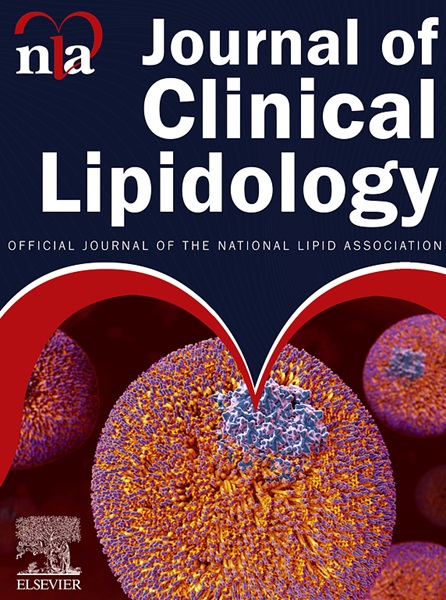巴西分子定义杂合子家族性高胆固醇血症患者的心血管疾病和降胆固醇治疗
IF 4.6
3区 医学
Q2 PHARMACOLOGY & PHARMACY
引用次数: 0
摘要
背景:关于发展中地区家族性高胆固醇血症(FH)流行病学的数据是基于当代的、按性别分类的分子定义的FH队列的。目的:评估参与级联筛查项目的分子定义杂合FH的男性和女性在心血管疾病(CVD)结局和降脂治疗(LLT)方面的差异。方法:纳入794例成年FH患者(年龄47±15岁,女性56.8%)。中位随访时间为59.0 (IQR 32.5-86.0)个月。结果:在基线时,在遗传缺陷、低密度脂蛋白胆固醇(LDL-C)年评分(男性和女性分别为12,687±6047和13,011±6576,P = .477)和强化LLT使用(男性和女性分别为74.7%和75.1%;P = .915)。男性患CVD的频率更高,30.4% vs 13.8% (P < 0.001)。在随访期间,男性和女性接受强化LLT的治疗相似(88.6%和87.8%;P = .983);然而,大多数参与者的LDL-C浓度仍然升高。男性和女性的事件发生率(1000患者年)分别为34.40 (95% CI: 26.21- 45.15)和17.69 (95% CI: 13.03-24.03) (P = 0.001)。当前吸烟(风险比[HR]: 3.058, 95% CI: 1.597-5.885, P < 0.001)、角膜弧度(HR: 1.763, 95% CI: 1.092-2.847, P = 0.02)、既往心血管疾病(HR: 1.704, 95% CI: 1.006-2.887, P = 0.048)、甘油三酯(HR: 1.002, 95% CI: 1.000-1.003, P = 0.008)和高密度脂蛋白胆固醇(HR= 0.975, 95% CI: 0.953-0.998, P = 0.033)与事件事件独立相关。结论:患FH的男性比女性患CVD的风险更高、更早;治疗强度没有差异,大多数患者仍保持高LDL-C。本文章由计算机程序翻译,如有差异,请以英文原文为准。

Cardiovascular disease and cholesterol lowering therapy in women and men with molecularly defined heterozygous familial hypercholesterolemia from Brazil
BACKGROUND
Data on the epidemiology of familial hypercholesterolemia (FH) in developing regions based on contemporary, molecularly defined FH cohorts categorized by sex are scarce.
OBJECTIVE
Evaluate the differences in cardiovascular disease (CVD) outcomes and lipid-lowering therapy (LLT) between men and women with molecularly defined heterozygous FH participating in a cascade screening program.
METHODS
We included 794 adult FH patients (age 47 ± 15 years, 56.8% women). The median follow-up was 59.0 (IQR 32.5-86.0) months.
RESULTS
At baseline, there were no sex differences regarding genetic defects, low-density lipoprotein cholesterol (LDL-C) years score (12,687± 6047 and 13,011 ± 6576 in men and women, P = .477), and intensive LLT use (74.7% and 75.1% in men and women; P = .915). Men had a higher frequency of prior CVD, 30.4% vs 13.8% (P < .001). During follow-up, men and women were treated similarly with intensive LLT (88.6% and 87.8%; P = .983); however, most participants remained with elevated LDL-C concentrations. The rate of events (1000 patient-years) was 34.40 (95% CI: 26.21-45.15) and 17.69 (95% CI: 13.03-24.03) for men and women, respectively (P = .001). Current smoking (hazard ratio [HR]: 3.058, 95% CI: 1.597-5.885, P < .001), corneal arcus (HR: 1.763, 95% CI: 1.092-2.847, P = .02), prior CVD (HR: 1.704, 95% CI: 1.006-2.887, P = .048), triglycerides (HR: 1.002, 95% CI 1.000-1.003, P = .008) and high-density lipoprotein cholesterol (HR: 0.975, 95% CI: 0.953-0.998, P = .033) were independently associated with incident events.
CONCLUSIONS
Men with FH were at a higher and earlier CVD risk than women; there was no difference in treatment intensity, with most patients remaining with high LDL-C.
求助全文
通过发布文献求助,成功后即可免费获取论文全文。
去求助
来源期刊
CiteScore
7.00
自引率
6.80%
发文量
209
审稿时长
49 days
期刊介绍:
Because the scope of clinical lipidology is broad, the topics addressed by the Journal are equally diverse. Typical articles explore lipidology as it is practiced in the treatment setting, recent developments in pharmacological research, reports of treatment and trials, case studies, the impact of lifestyle modification, and similar academic material of interest to the practitioner.
Sections of Journal of clinical lipidology will address pioneering studies and the clinicians who conduct them, case studies, ethical standards and conduct, professional guidance such as ATP and NCEP, editorial commentary, letters from readers, National Lipid Association (NLA) news and upcoming event information, as well as abstracts from the NLA annual scientific sessions and the scientific forums held by its chapters, when appropriate.

 求助内容:
求助内容: 应助结果提醒方式:
应助结果提醒方式:


